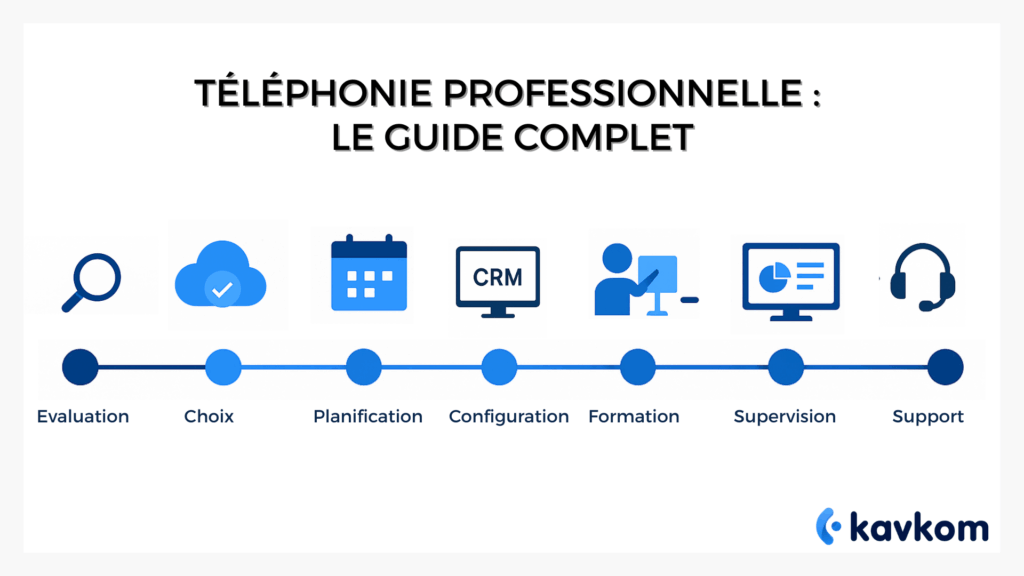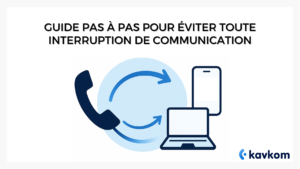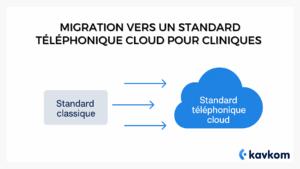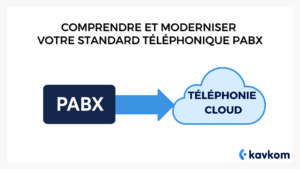Discover the ultimate guide to transforming your telephony. Here, you’ll follow 7 clear steps to migrate to a modern, commitment-free cloud solution and optimize your switchboard. This guide offers practical advice on how to simplify installation, strengthen CRM integration and boost business performance.
Points to remember
- Cloud telephony replaces costly, inflexible traditional systems with a solution that’s simple, flexible and quick to deploy.
- A modern switchboard enhances the customer experience with HD call quality, CRM integration and real-time supervision.
- No-commitment models and pro rata billing adapt to real business cycles and reduce fixed costs.
- Migrating to a professional telephony solution requires you to identify your needs, compare offers and plan a gradual switchover.
Why migrate to modern business telephony?
Do you remember the days when every change to your telephony system required a technician, cables pulled in every direction and a lengthy bill? For manycompanies, this reality is still with us: bulky equipment, rigid subscriptions, hidden costs and near-zero flexibility.
However, the business needs have changed. Sales teams juggle between telecommuting and the office, customer services need to respond fast and everywhere, and the size of your business can vary from season to season. Being stuck with fixed-line telephony inherited from the 2000s is like running a marathon in dress shoes: possible, but tedious and inefficient.
Modern telephony, supported by the cloud, removes these burdens. It requires no server cabinets, just a simple Internet connection. It adapts instantly: adding a new line takes just a few clicks, integrating your CRM becomes natural, and HD call quality makes conversations clear even on a laptop.
Professionals who take the plunge also discover another freedom: that of paying only for what they use. Gone are the days of
The benefits of cloud telephony for your business
Switch to cloud telephonyisn’t just about changing tools. It means transforming the way your company communicates, both internally and with its customers. With a cloud-hosted telephony solution, the limitations of traditional fixed and mobile telephony are a thing of the past. You gain agility, clarity and peace of mind, whether in the office or working remotely.
The strength of this model lies in its ability to bring all your interactions together in a single point: a platform capable of offering truly unified communication, with options that adapt to the reality of your teams. Rather than multiplying disparate systems, everything is managed via a single interface, accessible via the Internet.
HD call quality and CRM integration
A decision-maker’s first expectation? That every telephone exchange is clear. Thanks to HD call quality, the voice becomes fluid and free of static. Behind this clarity lies VoIP technology (or IP telephony, based on the SIP protocol), which enables conversations to be transmitted over the Internet with proven reliability.
But quality doesn’t stop at sound. Seamless integration with your CRM tools turns telephony functionality into a strategic asset. Every incoming or outgoing call is linked to customer data, so agents don’t have to juggle multiple screens.
Flexibility and no strings attached
Another advantage of the cloud is its freedom. No heavy investment, no fixed constraints. Subscriptions are designed to grow with your business: it’s easy to add several lines, manage incoming and outgoing calls, or adjust your mobile lines.
With Kavkom, this flexibility comes into its own. The solution can be used on a computer, cell phone or even a physicalIP phone, at no extra cost. You can pause your service in summer, resume it at the start of the new school year, and pay only for what you use. In short, commitment-free telephony designed for your actual cycles, not those of a supplier.
Mini comparison table
| Classic problem | Kavkom cloud solution |
|---|---|
| Long-term commitment | No commitment, pro rata billing |
| Unrestricted calling | Simple management of incoming and outgoing calls |
| A single support | Multi-support (PC, mobile, IP phone) |
| Rigid rates | Adjustable subscription based on usage |
Assess your business telephony needs
Before changing tools, take an accurate picture of your corporate telephony. How many calls per day, which peaks, which mix of incoming and outgoing calls, which sites, which mobile uses. Your
Then list your business constraints: queues, opening hours, languages, registration, supervision, CRM integration. Choose a telephony package that suits the seasonality, volume and size of your business, rather than a generic bundle. The objective: simple sizing, clear rights, a pro phone line for each useful role, and a switchboard type adapted to the desired routing. A good switchboard avoids detours and lost calls.
Quick checklist
- Call volume and distribution
- Locations, teleworking, working hours, languages
- Business tools to connect (CRM, helpdesk)
- Team roles and rights
- Indicators to monitor from D+1
Identify your essential functionalities (switchboard, VoIP, etc.)
Get to the heart of the matter: which features serve your teams on a day-to-day basis. For reception and routing, a virtual switchboard is often all you need. Need a more robust architecture? Aim for a professional switchboard. Include an interactive voice server to guide callers, clear messaging, configurable queues and recording if you coach agents.
When it comes to transport, rely on VoIP telephony(IP telephony) and check that the solution offers a switchboard that’s easy to control. ANSSI reminds us that ToIP brings together voice and data networks: the architecture must be segmented, controlled and monitored to remain reliable and available. The ” Securing a IP telephony architecture “guide details these design and operating points.
Choosing the right cloud telephony solution
Your starting point: clarify your business needs, then map the available telephony solutions. Look for a
When it comes to business models, avoid opaque bundles. A good player will clearly indicate what’s included, the price scale, and the options. This is useful if you manage a mixed fleet: historical fixed lines such as fixed line pro fixed-line offer for one site, and a fleet of mobile packages for the field. The important thing is to be able to manage everything from the same place, with clear rules.
Kavkom fits into this framework: rapid configuration, simple CRM integration, pro rata billing, no commitment. The platform meets the professional telephony needs of call centers and SMEs, with a short learning curve and predictable costs.
Compare offers and check compatibility with your tools
Put all the offers on the table, including your current operator ‘spro offer and, for reference, the offers visible on Google. The aim is not to return to corporate fixed-line telephony, but to understand the scope: fixed-line telephony solutions, professional fixed-line telephony, fixed-line telephone subscriptions, fixed lines still in service. Compare item by item: audio quality, integrations, administration, reporting, contractual conditions.
As far as compatibility is concerned, test on a real perimeter: contact synchronization, call logs in the CRM, file feedback, SSO. A good professional fix isn’t enough if the tool doesn’t speak to your stack. Kavkom ticks these boxes: APIs, connectors, and quick set-up without IT work.
Planning migration without interruption
Draw up a precise schedule: inventory of numbers, breakdown by site/team, switchover window. Anticipate the Internet connection: speed, fiber access, QoS. On sensitive sites, plan for 4G/5G redundancy via internet box or pro box.
Order the switchover: batch portability, testing, short training sessions, then go-live during off-peak hours. Communicate widely to avoid “surprise D-day”. With Kavkom, go-live is fast and reversible: handy if you need to stagger the stages.
Migration timeline
| J-30 | J-7 | J-1 | J0 |
|---|---|---|---|
| Inventory, planning | Network/QoS testing | Portability batch 1 | Go-live + monitoring |
Setting up and configuring your new tool
Start with the basics: import users, assign a phone line telephone linecall rules, SIP/VoIP trunking. Stabilize the landline or landline telephone legacy if you keep several landlines on certain sites. Set up queues, schedules, messages and the telephone system for recording and supervision.
Kavkom makes this phase easy: pre-configured profiles, IVR templates, CRM integration in just a few clicks. Finalize with a pilot batch before rolling out on a larger scale.
Installation checklist
- Users, roles, numbers
- IVR, messages, schedules
- Portability, referrals, queues
- CRM: field mapping, testing
- Security: MFA, logging.
Train your teams in the new telephony
Without adoption, no results. Plan
Deliver concise support material (PDF files, 3-minute videos), followed by a Q&A on D+3. With Kavkom, the interface remains light, so you’ll be up and running in no time, with no cognitive overload.
Training plan (3 x 60 min)
- User: calls, transfers, hold
- Manager: supervision, recording, coaching
- Admin: roles, numbers, routing.
Supervise and optimize your switchboard performance
Get into management mode: define your KPIs and track them over time. For switchboards, measure response time, abandonment rate, average length of call, perceived quality. A professional switchboard opens the way to fine-tuning: schedules, priorities, skills.
Cross-reference fixed and mobile telephony flows with your CRM data for clear, unified communication. In the Kavkompro customer area, dashboards and CSV exports help you spot bottlenecks and quickly adjust routing or teams.
Minimum dashboard
| KPI | Threshold | Action |
|---|---|---|
| Drop-out rate | < 5 % | Reinforcing niches |
| ASA (sec) | < 20 | Adjust files/routing |
| Quality (MOS) | ≥ 4,0 | Check QoS/RTP |
Deployment also depends on support. Look for a partner who knows telephony services, speaks the language of enterprise telephony, and understands SMBs. Compare experience in the field “
When your business rises or falls, you adapt the licenses, not the infrastructure. This elasticity is worth more than a seasonal discount. Your system keeps pace with the times, with no need for replastering.
FAQ – Frequently asked questions
Why migrate to a modern cloud telephony solution rather than stick with a traditional system?
A conventional system requires hardware, maintenance and high fixed costs. A cloud telephony solution, on the other hand, is based on the Internet. It deploys quickly, reduces costs and supports your growth. Modern telephony frees you from hardware constraints and keeps you agile.
What are the concrete benefits of cloud telephony for managing corporate communications?
For corporate telephony, the benefits are many: HD calls, CRM integration, real-time supervision, multi-media (PC, mobile, IP). Teams gain in efficiency and customers benefit from a better experience.
How do you assess specific business telephony needs before migrating?
Start by mapping your usage: number of lines, call volume, mobility, desired integrations. This will help you avoid an ill-sized subscription. Think about key features (IVR, recording, messaging). In short, make a precise inventory before choosing the right offer.
What criteria should I use to choose the right cloud telephony solution for my tools and my business?
Compatibility is key. Check that the platform supports VoIP and IP telephony, that it connects to your business tools, and that it offers a no-commitment model. A telephone line must be easy to add or suspend.
How do you plan and execute a migration without service interruption?
Preparation is everything: inventory, step-by-step planning, network tests, internal communication. The changeover is carried out in batches, often during off-peak hours to minimize risk. A support team available in parallel secures the transition.
Conclusion
Adopting a business telephony solution means rethinking the way your organization communicates. Professional cloud telephony provides flexibility, quality and simplicity that traditional systems can no longer offer. Among the telephony solutions available, those designed for the growth of SMEs and call centers, such as Kavkom, offer real value: rapid installation, seamless integration, adjustable billing.
The next step is up to you: moving from telephony that holds you back to business telephony that supports your ambitions. With the right business telephony, you’ll gain in productivity and peace of mind, from the very first call.





